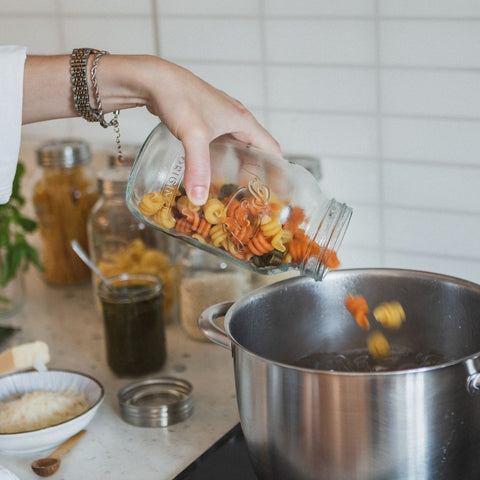Are glass storage containers better than plastic?
Food storage makes our daily lives comfortable and helps us to avoid waste.
Learning how to store food is essential to keeping us healthy. Healthy Cookware explains that storing your food correctly is one of the best ways to protect yourself and your family from food poisoning. If food is not stored correctly and chilled, the harmful bacteria can proliferate, leading to food spoilage and possible illness. "
However, many of us need clarification about where and how to store our leftovers. What are the pros and cons of using glass containers for food storage? How much safer are glass containers than plastic containers? How can one properly clean and maintain glass containers for long-term use?
A common question is what packaging material to store fruits, vegetables, and liquids. Plastic and glass are popular options.
This article will compare glass and plastic containers, discussing the pros and cons of each to recommend which is most suitable.

Food storage containers
Food containers were created to store food and drinks for later transportation. Thus, the history of packaging follows the history of logistics and food transportation.
In ancient times, people did not have to worry about packing food. They would simply consume what they hunted or harvested locally. During the prehistoric period, many nomadic tribes would travel for food and water, often depleting these resources in their place of origin.
With the rise of sedentary lifestyles, food and drinks need packaging for storage and transportation.
The first types of food containers were made from 100% organic raw materials available in nature. Bark, leaves, and other natural materials were used for packing and transporting food.
Quote: Would you like to learn more about the history of packaging? Check our article: The History of Packaging: learn from the past and build today's innovation.
Throughout history, humans have used various materials to create packaging, including glass, cans, paper, and Plastic.
Next, we will discuss the characteristics, similarities, and differences between glass and plastic containers.
Plastic containers
Until recently, plastic containers were trendy. They won the preference of families for being cheap and light. Families used plastic containers for everything, like heating food in microwaves and keeping their soups hot.
Recently, concerns have been raised about the negative impact of plastic on human health and the environment.
Aware of the plastic container issues, Toronto University warns their students: "Plastic is the easiest, cheapest option for food storage, but not always the smartest. While plastic containers are great for cold storage, traveling around, or for bringing food to things like potlucks (so you can leave it behind), when it comes to storing hot food and using to re-heat last night's dinner, you want to steer clear."
There are different types of plastic. As Earth 911 explains, "Two types of plasticizers, which are substances added to plastic to help stabilize and shape it, are of concern to human health: bisphenol-A (BPA) and phthalates. These substances are believed to be "endocrine disrupters," which means they mimic human hormones and can cause chronic health risks. These can leach into the food or beverage from the plastic when it's heated. There is also evidence that some acidic foods can cause leaching without being heated."
It's essential to be aware that while convenient and affordable, plastic containers can pose health risks due to the chemicals used in manufacturing. This is especially true when you store hot food that has just come out of the oven or stove in them, as well as when you heat up hot food in these containers in the microwave. It's best to be cautious with your use of plastic containers to ensure your health and safety.
Quote: Would you like to learn more about the effects of plastic on the human body and the environment? Check out our article: What is Plastic, how and why was it created?
Another problem with plastic containers is their low durability. Over time, they lose their colours and become old and worn.
There is also a significant issue with the low recycling rate of plastic, which harms the environment.
Due to these issues, some consumers have opted for alternative solutions. One such solution is to return to using glass containers. Learn more below.
Glass containers
Glass containers are the oldest packaging material humans have used, after wood and other organic materials. Before glass containers, humans stored their food in tree bark and leaves.
Quote: Would you like to learn more about the history of packaging? Check our article: The History of Packaging: learn from the past and build today's innovation.
Commercial glass is produced through a mixture of sand, recycled glass, soda ash, and limestone.
Glass is a non-porous material that prevents the accumulation of dirt and bacteria susceptible to other materials. Glass containers are practical and straightforward to clean.
Glass containers are an excellent choice for those who want to reduce waste. They are durable and can be reused for many years. Simply wash them well, and they will look as good as new. This is one of the most significant advantages of glass containers, as they can be reused as often as you want.
If you avoid thermal shock, glass containers can be used to store both hot and cold food. Unlike plastic containers, glass can withstand high temperatures, making them suitable for oven and stove use.
Quote: When it does come time to retire your glass containers, they're easier to recycle than their plastic counterparts, so you can rest easy knowing you're still eco-friendly (Toronto University).
Glass containers are recycled more than plastic containers and can be 100% recycled endlessly.
Quote: Glass is 100% recyclable and can be recycled endlessly without loss in quality or purity - something few food and beverage packaging options can claim (Glass Packaging Institute).
Would you like to learn more about packaging made with recycled glass? Check out our article: Wild Recycled Glass: a sustainable bottle made with up to 100% recycled glass.
You now have a lot of information about plastic and glass containers. However, an excess of information can sometimes be confusing. To help you reflect, we have prepared a summary of the advantages and disadvantages of glass and plastic containers. Please check it out!
Plastic versus glass containers
Check below some pros and cons of plastic and glass packaging.
Advantages of plastic containers
- They're lightweight;
- Easily portable ;
- It won't break if dropped;
- They are cheap;
Disadvantages of plastic containers
- Plastic is one of the most polluting materials in the world;
- Harmful chemicals from plastic containers may migrate from the plastic into your food;
- Some plastic containers can get warped in contact with hot food;
- Plastic storage can absorb stains and the smell of the foods you keep in it;
- It is not safe to wash all the plastic storage in dishwashers at high temperatures;
- Plastic containers can't go to the oven or the stove;
- Wears out over time, gaining scratches and losing colour;
Advantages of glass
- Glass doesn't absorb food and germs;
- Glass jars are safe to wash glass at high temperatures in your dishwasher;
- Glass can be recycled endlessly, being eco-friendly;
- Glass containers offer beautiful design and aesthetics;
- Glass is a non-porous material, so the surface doesn't absorb stains, food, and germs.
- Glass containers don't absorb stains and the smell of the foods you keep in them.
- Glass storage has long durability.
- Glass jars hold heat and are compatible with the stove, oven, and microwave.
Would you like to learn more about the benefits of glass containers? Check our article: 3 Exclusive Benefits of Glass Packaging.
Disadvantages of glass
- Glass containers tend to be heavier than plastic and are not as easily portable.
- Glass packaging is typically more costly compared to plastic packaging.
- Glass containers need to be handled with extra care.
- If dropped glass jars can break easily.
Sustainable and healthy packaging for storing food
As plastic packaging for storing food is associated with various problems, businesses and consumers alike are looking for more sustainable and healthier packaging options. Glass packaging, with innovative designs and shapes, is emerging as a popular alternative. Pearl Jars is a European company that offers solutions for the sustainable glass packaging industry.

Pearl offers versatile food storage solutions that combine beautiful design with functionality, making it perfect for storing a variety of fruits, vegetables, and other foods.
Don't miss out on the chance to share your food storage techniques! Leave a comment and let us know how you keep your food fresh. Your contribution could help others improve the food storage practices.

















